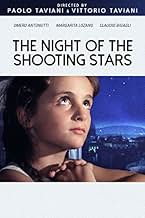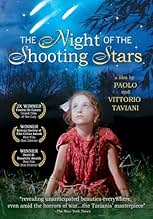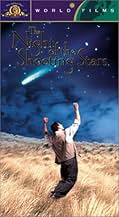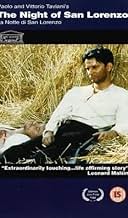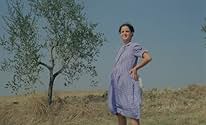AVALIAÇÃO DA IMDb
7,2/10
4,9 mil
SUA AVALIAÇÃO
Adicionar um enredo no seu idiomaIn 1944, the residents of a small Italian town under Axis control flee their homes to seek out the liberating Allied forces.In 1944, the residents of a small Italian town under Axis control flee their homes to seek out the liberating Allied forces.In 1944, the residents of a small Italian town under Axis control flee their homes to seek out the liberating Allied forces.
- Direção
- Roteiristas
- Artistas
- Prêmios
- 19 vitórias e 13 indicações no total
Sergi Dagliana
- Olinto
- (as Sergio Dagliana)
Avaliações em destaque
The fraternal filmmaking team of Paolo and Vittorio Taviani recall the closing days of World War II with mingled affection and pain, looking back at the fate of one small northern Italian village (ostensibly their own childhood home) set in the path of opposing armies. Combining their typically lyrical approach to storytelling with a remarkable feel for setting, the two directors follow a small group of villagers as they steal through enemy lines one night in an attempt to meet the advancing Allied troops. Seen through the rose-colored lens of memory, the Taviani brothers' episodic reminiscences take the horror (but not the hurt) out of battle, reducing all the bloodshed and rage to a poignant and distinctly recalled tragedy.
10jotix100
The night of August 10th, when the feast of St. Lawrence is observed, is the time of the year when meteor showers can be observed in the sky. It has been a tradition in the western culture that wishing for a favor when watching the falling stars in the sky is a way to ask for love, riches and luck. The sky watchers can expect a spectacle like no other because of the way those distant lights are seen falling, fast and furious.
The brothers Taviani, Paolo and Vittorio, have always come out with interesting films that involve simple people, usually connected to the land. In "La Notte di San Lorenzo", the Tavianis take the viewer to witness a group of people from Tuscany during the last days of WWII. The story is told by a 6 years old girl who was too young to realize the horrors around her in those final days of the conflict.
In spite of the approaching American liberating army, there are still the horrible local Fascists, who knowing they were fighting a losing battle, terrorized their neighbors into submission. These misguided people, having mined most of the houses in the town, are feared by the local population. Some flee into the countryside, but some remain in the town, convinced that being in the big church will protect them against evil.
Things go from bad to worse. We see different vignettes involving some of the people, as they cope with the situation. There is Galvano, who has loved Concetta in silence and is finally, as in a miracle, gets his wish granted in the way that she acknowledges that she has always love him, even after both have been married to different people. There's the young pregnant young bride, who is expecting and who gets married at the beginning of the film, only to be separated from her husband in an ironic twist.
The Tavianis painted a huge canvas in which they situated the action. Tuscany in the summer is a lovely place to be, but one can't even comprehend that it was also the scene for the tragedy lived in Italy in those tragic years. The music by Nicola Piovani is effective in the background. Franco DiGiacomo's photography does wonders to make the film a great experience. The large cast does an excellent job for the Tavianis, who are ultimately, the ones to thank for their courage in presenting us this lyrical movie of beauty and death.
The brothers Taviani, Paolo and Vittorio, have always come out with interesting films that involve simple people, usually connected to the land. In "La Notte di San Lorenzo", the Tavianis take the viewer to witness a group of people from Tuscany during the last days of WWII. The story is told by a 6 years old girl who was too young to realize the horrors around her in those final days of the conflict.
In spite of the approaching American liberating army, there are still the horrible local Fascists, who knowing they were fighting a losing battle, terrorized their neighbors into submission. These misguided people, having mined most of the houses in the town, are feared by the local population. Some flee into the countryside, but some remain in the town, convinced that being in the big church will protect them against evil.
Things go from bad to worse. We see different vignettes involving some of the people, as they cope with the situation. There is Galvano, who has loved Concetta in silence and is finally, as in a miracle, gets his wish granted in the way that she acknowledges that she has always love him, even after both have been married to different people. There's the young pregnant young bride, who is expecting and who gets married at the beginning of the film, only to be separated from her husband in an ironic twist.
The Tavianis painted a huge canvas in which they situated the action. Tuscany in the summer is a lovely place to be, but one can't even comprehend that it was also the scene for the tragedy lived in Italy in those tragic years. The music by Nicola Piovani is effective in the background. Franco DiGiacomo's photography does wonders to make the film a great experience. The large cast does an excellent job for the Tavianis, who are ultimately, the ones to thank for their courage in presenting us this lyrical movie of beauty and death.
There are many ways to portrait war, and the Tavianis choose a very circuitous one: By showing it through the eyes of a group of refugees - who, naturally, try to stay away from the fights as much as possible. Many of those refugees are real characters, with little stories of their own, so it's less a film about the actual WW2, but rather about how people react to war as a whole, how it can bring out the best (or worst) in a man and how it upsets everything you took for granted.
One of the nicest things about "La notte di San Lorenzo" is how there's always something lovely or funny to be found - comic or beautiful situations under the direst of circumstances, even if the laughter dies in your throat a few seconds later when violence cruelly rises again. This film celebrates life and humanity itself!
One of the nicest things about "La notte di San Lorenzo" is how there's always something lovely or funny to be found - comic or beautiful situations under the direst of circumstances, even if the laughter dies in your throat a few seconds later when violence cruelly rises again. This film celebrates life and humanity itself!
This film is an eye-opening look at Italian life during WWII. It reminds me of the stories my grandfather tells me of his life in 1930s Florence during the war, "We didn't have money for anything, not even water. The rich had it all." This movie shows us the sparseness of their lives, and the things that they still hold dear. There are scenes in which it is almost hard to watch, we are torn apart by the brutality of the war, but we are entranced by the people who are living through it. We meet ruthless fascists, and caring catholic priests and every moment describes to us the terrifying truth, and the hope that lets one continue. I could not imagine a more realistic, and emotional epic on the subject.
The Night of the Shooting Stars is the semi-autobiographical recollection by the Taviani Brothers of the night when a group of peasants in a small Tuscan village left their homes that had been mined by the Fascists to look for liberating American soldiers rumored to be on the outskirts. Set on the night of the Feast of St. Lawrence in the closing days of World War II, and enhanced by a haunting score by Nicola Piovani, the film is a tragi-comic glimpse of what the war was like to an impressionable child filtered through years of memory. It is essentially a series of vignettes combining fact, memory, and poetic imagination told in flashback by a mother recalling her days as a 6-year old girl named Cecilia caught in the middle of war.
The film focuses on the nature of a conflict in which life long friends from the same village are often engaged in the struggle on different sides. Especially vivid is a scene involving a battle in a wheat field between the villagers and home grown Fascists, and a heart wrenching confrontation between the partisans and a father with his 15-year old son. There are many other poignant moments as well: a young couple expecting a child, the village priest who is a collaborator, and an elderly couple rekindling a romance started when they were adolescents.
Night of the Shooting Stars pays homage to the tradition of neo-realism, but also includes surrealistic moments such as when the young girl sees the partisans as Greek warriors, while the Fascist who threatens her life falls dead, pierced by multiple spears. Though Night of the Shooting Stars suffers from overacting, its unique approach allows us to see war as a very personal experience with all of its sadness and cruelty. It was also gratifying to see Americans being held in high esteem, an experience we haven't enjoyed much of recently.
The film focuses on the nature of a conflict in which life long friends from the same village are often engaged in the struggle on different sides. Especially vivid is a scene involving a battle in a wheat field between the villagers and home grown Fascists, and a heart wrenching confrontation between the partisans and a father with his 15-year old son. There are many other poignant moments as well: a young couple expecting a child, the village priest who is a collaborator, and an elderly couple rekindling a romance started when they were adolescents.
Night of the Shooting Stars pays homage to the tradition of neo-realism, but also includes surrealistic moments such as when the young girl sees the partisans as Greek warriors, while the Fascist who threatens her life falls dead, pierced by multiple spears. Though Night of the Shooting Stars suffers from overacting, its unique approach allows us to see war as a very personal experience with all of its sadness and cruelty. It was also gratifying to see Americans being held in high esteem, an experience we haven't enjoyed much of recently.
Você sabia?
- CuriosidadesThe church scene, where Germans bomb the church full of people, was based on real life events that took place in San Miniato (the birthplace of Paolo Taviani and Vittorio Taviani). However, more than two decades after this movie was made, the case was reopened and it was discovered, that the fatal bomb actually belonged to the American army, and hit the church accidentally.
- Erros de gravaçãoA man, likely Dilvo, raises watermelon to his mouth with both hands, but in the next shot is eating it only with the right hand.
- ConexõesFeatured in Marcello Mastroianni: Eu me Lembro Sim, Eu me Lembro (1997)
Principais escolhas
Faça login para avaliar e ver a lista de recomendações personalizadas
- How long is The Night of the Shooting Stars?Fornecido pela Alexa
Detalhes
- Data de lançamento
- País de origem
- Idiomas
- Também conhecido como
- The Night of the Shooting Stars
- Locações de filme
- Empoli, Tuscany, Itália(church bombing scene on Piazza Farinata degli Uberti)
- Empresas de produção
- Consulte mais créditos da empresa na IMDbPro
Bilheteria
- Faturamento bruto nos EUA e Canadá
- US$ 2.257.307
- Fim de semana de estreia nos EUA e Canadá
- US$ 4.414
- 16 de ago. de 2015
- Faturamento bruto mundial
- US$ 2.257.307
- Tempo de duração
- 1 h 47 min(107 min)
- Mixagem de som
- Proporção
- 1.66 : 1
Contribua para esta página
Sugerir uma alteração ou adicionar conteúdo ausente




